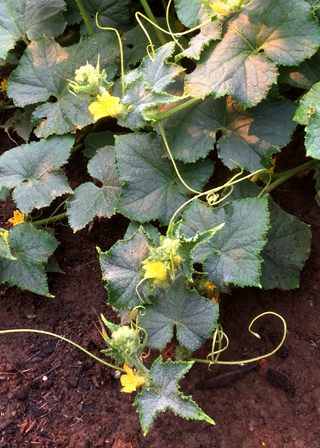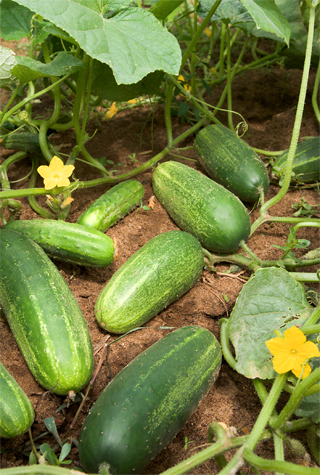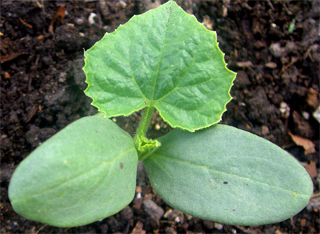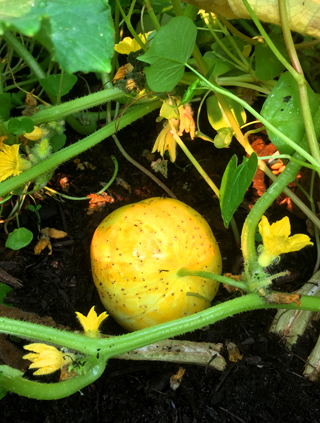
How to Grow Cucumbers in Oregon, Washington and B.C.
The annual garden plant, cucumber (Cucumis sativus,) is a large-leaved trailing vine. A member of the family Curcurbitacae along with squash, melons and pumpkins, it has been cultivated for around 3000 years. Having originated from desert plants in the East Indies, they have a deep, water-seeking tap-root, and prefer hot, dry conditions to cold and damp. Once cool spring weather has passed, cukes grow rapidly and will thrive almost anywhere in the Pacific Northwest.
The vines can grow up to ten feet in a season and, along with the fruits, are covered with small, hair-like spines. The fruits will be spinier in dry weather. All types carry male and female flowers separately on each vine.
Varieties of cucumbers range from small pickling size to long, straight slicing types, to the Armenian or “snake melon” which can reach three feet in length. (If grown so that fruit hangs down from a trellis, they will be long and straight; if grown on the ground, the Armenian will curl into its contorted “snake” form.)
Fruit colors range from deep green to white, red and orange. Slicing types are harvested when immature and eaten fresh.
Cucumbers and Your Health
Cucumbers are low in calories, having a high water content and are said to be helpful in digestion and in detoxifying the body as well as being a mild diuretic. The skin of the cucumber is a good source of fiber, so wash them well, but don’t peel (one more reason to grow them at home). Cukes are high in potassium and antioxidants and are a great source of vitamin-K.
Healthful salves and other skin and hair care products also made from the fruit.
Seasonal Guide
Spring
- Prepare raised beds and erect trellising if desired.
- Start seeds indoors in mid to late April.
Late spring
- Harden off and set out seedlings when both days and nights are warm (around the beginning of June in the Pacific Northwest.)
- Cukes can also be planted from seed in the garden at this time.
Summer
- Mulch in July when ground is thoroughly warm.
- Feed every 3-4 weeks with a side-dressing of complete liquid fertilizer.
- Pinch over-long vines to encourage branching.
- Begin harvest of small fruits.
- Pick any overly-large fruit and compost or feed to chickens.
Fall
- Pull and compost vines.
Location
Cucumbers do well in raised beds with good drainage and air circulation to prevent powdery mildew. If no raised bed is available, plant in low hills in an exposed sunny, warm location. Remember to leave room for the long vines to spread.
Soil Prep
Sandy, limey loam is best. Work in complete organic fertilizer with additional fertilizer or finished compost in each hill.
Planting
Plant in hills 2’-3’ apart for upright types, 3′-4’ for vigorous spreaders. Put 4-5 seeds in the top of each hill and cover lightly with soil. Avoid watering until seedlings are up and growing – sprouts are very susceptible to powdery mildew caused by cool, damp conditions. If the weather turns cool and rainy after planting reseed as soon as it warms up.
When the plants have two true leaves, thin to the one or two most robust plants in each hill.
Cultivate for weeds carefully to avoid root damage and mulch to conserve water when soil is thoroughly warm.
Water
Despite originating as a desert plant, modern cucumber strains require deep regular watering. Avoid wetting the leaves to prevent mildew. A drip system will give good results.
Pests and Diseases
Powdery mildew is the greatest threat to happy cukes – keep plants warm and dry by planting after cool spring weather has passed.
Cucumber beetles feed on the leaves of young leaves and can also spread powdery mildew. The beetle larva also bores into the roots of plants. Treat with Pyrethrin.
Mosaic virus works in the stem, causing stunted growth and deformed fruit. It can be spread by hand or with tools that have touched infected plants. Remove and destroy afflicted plants.
Harvest
Cucumbers are harvested in a juvenile stage. If allowed to mature, they will be watery and tasteless. Keep vines picked clean for best production. Just a few hidden fruit that start to develop seed will cause flowering to slow. Pick at 2”-3” for sweet pickles, 5”-6” for dill pickles, and 6”-8” for slicing.




